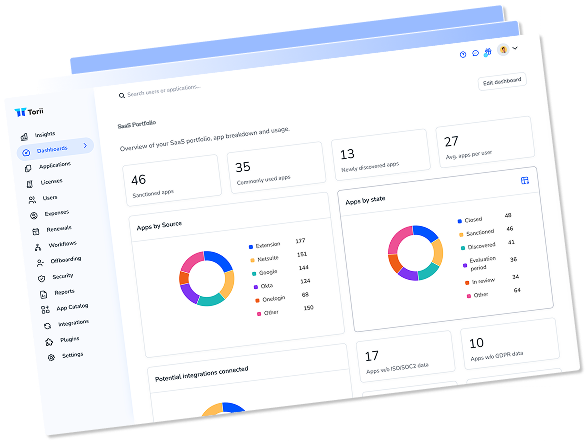Looking for the 101 on this topic? Check out our explainer: What is Shadow IT? [And Three Steps to Take in 2023]
Shadow IT, friend—foe… or something else?
Featured Video: What is Shadow IT? [Explainer]
Whether you think it’s good or bad, shadow IT is everpresent. Especially in the form of cloud apps.
Gartner states, “SaaS spend continues to grow by 15-20% annually, as organizations maintain an average of over 125 different SaaS applications totaling $1,040 per employee annually. IT typically is aware of only a third of those due to decentralized ownership and sourcing.”
And when we surveyed IT professionals in our Visibility and Impact Study, they said Shadow IT occurred due to:
- 7% Free trials or product-led growth
- 36% Line-of-business making individual purchases without IT knowledge
- 52% Individual users purchase their own solutions
So yes, while Shadow IT has grown considerably, it’s expected to only continue due to the following trends:
- SaaS adoption is increasing. More options exist because even more vendors are moving to SaaS business models.
- It is easy to signup and start using new tools. SaaS applications are becoming more self-served than before. Anyone can sign up and start using a new product to evaluate its benefits. In addition, many products offer free trials, affordable prices, or even free services, all reducing the barriers to adopting these tools.
- It is easy to integrate software. Different software is becoming more and more connected, sharing data and communicating effectively with each other.
- We are changing. As younger generations enter the workforce, the app store is as comfortable as the local shopping center. We are increasingly conditioned to find apps for our needs and adopt them without thoughts of downstream impacts.
Knowing that shadow IT is not just here to stay but is growing—let’s look at this trend’s good, bad, and ugly sides and see if we can identify the best path forward.
The Good
Shadow IT might get a bad reputation—representing our inability to get employees to “follow the rules.” But, the flip side of Shadow IT is that it represents employees problem-solving to tackle their work-related challenges. This is especially common since IT or Procurement cannot possibly understand the specific challenges of every employee. There are other benefits to this trend as well:
- Productivity: individual employees can often benefit from these new apps. Adopting cutting-edge tools exposes them to advanced capabilities as they emerge.
- Employee engagement: often, employees will become frustrated or disengaged at work when they don’t have the best tools. This trend is even more prevalent with younger workers. By adopting new tools, employees are often more motivated and can enjoy their work more.
- Competitive advantage: if an employee’s app exploration is adequately leveraged, it can result in a competitive advantage as your company is the first to adopt new capabilities.
- Free up IT resources: in our State of SaaS at work report, we asked 300 IT pros, and 49% said that shadow IT “frees up IT resources.”
The Bad
While you probably know the negatives associated with shadow IT, it’s worth reviewing:
- Lack of clarity: often, shadow IT emerges because there is a poor understanding of which apps are approved and which are not. Unfortunately, shadow IT will worsen this trend and expand the confusion, ultimately undermining attempts at SaaS governance.
- Wasted money: As easy as it is to adopt, SaaS can stack up on your expense sheet—fast. It’s common for 35% or more of a company’s SaaS spend to be wasted on idle or unassigned licenses. There’s also the cost of redundant tools as employees might add different tools with the same capabilities.
- It hurts collaboration: with distributed SaaS adoption, we also find distributed ownership, data, and insights. This scattering can prevent meaningful collaboration (as we explored in our State of SaaS at Work report – only 20% of IT teams collaborate “often” with other departments).
- Related: Check out Torii’s Distributed SaaS Management Playbook to learn about how to manage SaaS in a distributed app environment
- Related: Check out Torii’s Distributed SaaS Management Playbook to learn about how to manage SaaS in a distributed app environment
- Undermines security: unknown SaaS increases the surface area of possible attacks; it can also lead to former employees retaining access to critical IP. After all, you can’t govern or secure what you can’t see.
The Ugly
We’ve mentioned the good and the bad, but now it’s time for the (ugly) reality check. So often, shadow IT remains hidden until it’s too late, and the damage is done. The damage might be security, budgets, or reputation, but it can also have interpersonal ramifications. Embarrassment or even anger can often come from shadow IT and uncomfortable conversations about its use.
End-users have different incentives and priorities from IT. As a result, their quest for efficiency can directly hurt IT work, leading to major friction in the organization.
The Bottom Line
Shadow IT is here to stay. Employees will never stop testing shiny tools—no matter how many memos or browser monitoring tools are in place. However, that lockdown approach might be missing the point.
Shadow IT, in and of itself, is not the problem. A lack of visibility is the problem.
How To Address Shadow IT
The world of IT Management is changing (fast), but many organizations still need to keep up. Instead of fighting against shadow IT, many IT teams are learning to live with it (or even thrive with it). But that starts with illuminating the shadows.
It’s time to recognize that shadow IT is only dangerous so long as it can remain cloaked in darkness. By turning a spotlight on the corners of our SaaS stack, IT can address threats head-on without stifling coworkers’ innovative and experimental mindsets.
And that starts with discovery. Shadow IT can be discovered in many ways. At Torii, we leverage a multi-faceted discovery process that ingests data from your IdP, SSO, expense data, integrations, and even an optional browser extension to uncover every relevant business app in your company.
Are you looking to discover and eliminate Shadow IT in your organization? Torii is a full-fledged SaaS management platform that will guide you through it; request a demo to learn more!

